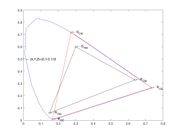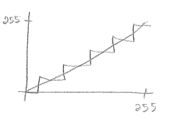| Line 5: | Line 5: | ||
[[Category:image processing]] | [[Category:image processing]] | ||
| − | = [[ECE_PhD_Qualifying_Exams|ECE Ph.D. Qualifying Exam]] | + | <br> |
| − | + | <center> | |
| + | <font size="4"> [[ECE_PhD_Qualifying_Exams|ECE Ph.D. Qualifying Exam]] </font> | ||
| − | + | <font size="4"> Communication Networks Signal and Image processing (CS) </font> | |
| + | |||
| + | <font size="4"> [[QE637_sol2012|Question 5, August 2012(Published on May 2017)]],</font> | ||
| + | |||
| + | <font size="4">[[ QE637_sol2012_Q1 | Problem 1]],[[ QE637_sol2012_Q2 |2]]</font> | ||
| + | </center> | ||
---- | ---- | ||
| + | |||
== Solution1: == | == Solution1: == | ||
Revision as of 09:48, 2 May 2017
Communication Networks Signal and Image processing (CS)
Question 5, August 2012(Published on May 2017),
Problem 1,2
Solution1:
a)
The gamma of the device is equal 1.
b)
$ \begin{align} & \left[ \begin{matrix} {{X}_{r}} \\ {{Y}_{r}} \\ {{Z}_{r}} \\ \end{matrix} \right]=\left[ \begin{matrix} a & b & c \\ d & e & f \\ g & h & i \\ \end{matrix} \right]\left[ \begin{matrix} 1 \\ 0 \\ 0 \\ \end{matrix} \right]\Rightarrow \left\{ \begin{matrix} {{X}_{r}}=a \\ {{Y}_{r}}=d \\ {{Z}_{r}}=g \\ \end{matrix} \right. \\ & {{x}_{r}}={{\frac{{{X}_{r}}}{{{X}_{r}}+{{Y}_{r}}+Z}}_{r}}=\frac{a}{a+d+g},_{{}}^{{}}{{y}_{r}}=\frac{{{Y}_{r}}}{{{X}_{r}}+{{Y}_{r}}+{{Z}_{r}}}=\frac{d}{a+d+g} \\ \end{align} $
$ \begin{align} & \left[ \begin{matrix} {{X}_{g}} \\ {{Y}_{g}} \\ {{Z}_{g}} \\ \end{matrix} \right]=\left[ \begin{matrix} a & b & c \\ d & e & f \\ g & h & i \\ \end{matrix} \right]\left[ \begin{matrix} 0 \\ 1 \\ 0 \\ \end{matrix} \right]\Rightarrow \left\{ \begin{matrix} {{X}_{g}}=b \\ {{Y}_{g}}=e \\ {{Z}_{g}}=h \\ \end{matrix} \right. \\ & {{x}_{g}}=\frac{{{X}_{g}}}{{{X}_{g}}+{{Y}_{g}}+{{Z}_{g}}}=\frac{b}{b+e+h},_{{}}^{{}}{{y}_{g}}=\frac{{{Y}_{g}}}{{{X}_{g}}+{{Y}_{g}}+{{Z}_{g}}}=\frac{e}{b+e+h} \\ \end{align} $
$ \begin{align} & \left[ \begin{matrix} {{X}_{b}} \\ {{Y}_{b}} \\ {{Z}_{b}} \\ \end{matrix} \right]=\left[ \begin{matrix} a & b & c \\ d & e & f \\ g & h & i \\ \end{matrix} \right]\left[ \begin{matrix} 0 \\ 0 \\ 1 \\ \end{matrix} \right]\Rightarrow \left\{ \begin{matrix} {{X}_{b}}=c \\ {{Y}_{b}}=f \\ {{Z}_{b}}=i \\ \end{matrix} \right. \\ & {{x}_{b}}=\frac{{{X}_{b}}}{{{X}_{b}}+{{Y}_{b}}+{{Z}_{b}}}=\frac{c}{c+f+i},_{{}}^{{}}{{y}_{b}}=\frac{{{Y}_{b}}}{{{X}_{b}}+{{Y}_{b}}+{{Z}_{b}}}=\frac{f}{c+f+i} \\ \end{align} $
c)
$ \begin{align} & \left[ \begin{matrix} {{X}_{w}} \\ {{Y}_{w}} \\ {{Z}_{w}} \\ \end{matrix} \right]=\left[ \begin{matrix} a & b & c \\ d & e & f \\ g & h & i \\ \end{matrix} \right]\left[ \begin{matrix} 1 \\ 1 \\ 1 \\ \end{matrix} \right]\Rightarrow \left\{ \begin{matrix} {{X}_{w}}=a+b+c \\ {{Y}_{w}}=d+e+f \\ {{Z}_{w}}=g+h+i \\ \end{matrix} \right. \\ & A={{X}_{w}}+{{Y}_{w}}+{{Z}_{w}}=a+b+c+d+e+f+g+h+i \\ & {{x}_{w}}=\frac{{{X}_{w}}}{{{X}_{w}}+{{Y}_{w}}+{{Z}_{w}}}=\frac{a+b+c}{A},_{{}}^{{}}{{y}_{w}}=\frac{{{Y}_{w}}}{{{X}_{w}}+{{Y}_{w}}+{{Z}_{w}}}=\frac{d+e+f}{A} \\ \end{align} $
d)
$ (X,Y,Z)=(0,1/2,1/2)_{{}}^{{}}\Rightarrow _{{}}^{{}}(x,y)=(0,1/2) $As can be seen, since the point lies outside the horseshoe shape diagram, it’s doesn’t exist (imaginary color) while mathematically we can talk about it and write down the equation for it. For this point, R<0, G>0, and B>0.
e) We see false contours in dark region, because small changes in quantization level leads to large contrast changes that cause visible contours.
Solution 2:
a) $ \left[ {\begin{array}{*{20}{c}} R\\ G\\ B \end{array}} \right] $ are linear with energy $ \Rightarrow $ $ \gamma=1 $.
b)
$ \left[ {\begin{array}{*{20}{c}} X\\ Y\\ Z \end{array}} \right]=M\left[ {\begin{array}{*{20}{c}} 1\\ 0\\ 0\\ \end{array}} \right] \Rightarrow (x_r,y_r)=(\frac{a}{a+d+g},\frac{d}{a+d+g}) $
$ \left[ {\begin{array}{*{20}{c}} X\\ Y\\ Z \end{array}} \right]=M\left[ {\begin{array}{*{20}{c}} 0\\ 1\\ 0\\ \end{array}} \right] \Rightarrow (x_g,y_g)=(\frac{b}{b+e+h},\frac{e}{b+e+h}) $
$ \left[ {\begin{array}{*{20}{c}} X\\ Y\\ Z \end{array}} \right]=M\left[ {\begin{array}{*{20}{c}} 0\\ 0\\ 1\\ \end{array}} \right] \Rightarrow (x_b,y_b)=(\frac{c}{c+f+i},\frac{f}{c+f+i}) $
c)
$ \left[ {\begin{array}{*{20}{c}} X\\ Y\\ Z \end{array}} \right]=M\left[ {\begin{array}{*{20}{c}} 1\\ 1\\ 1\\ \end{array}} \right] \Rightarrow {{x}_{w}}=\frac{a+b+c}{a+b+c+d+e+f+g+h+i}, {{Y}_{w}}=\frac{d+e+f}{a+b+c+d+e+f+g+h+i} , {{Z}_{w}}=1-{{x}_{w}}-{{x}_{w}}. $
R is negative and B and G are positive.
The student can be more specific about the positive or negative of each R,G,B value of this color.
e) Artifacts in dark regions of gradient where human contrast sensitivity is higher (more sensitive to quantization error).
Related Problem
Consider a color imaging device that takes input values of $ (r,g,b) $ and produces ouput $ (X,Y,Z) $ values given by
$ \left[ {\begin{array}{*{20}{c}} X\\ Y\\ Z \end{array}} \right] = \left[ {\begin{array}{*{20}{c}} a&b&c\\ d&e&f\\ g&h&i \end{array}} \right]\left[ {\begin{array}{*{20}{c}} r^\alpha\\ g^\alpha\\ b^\alpha \end{array}} \right] $
a) Calculate the white point of the device in chromaticity coordinates.
b) What are the primaries associated with the r,g, and b components respectively?
c) What is the gamma of the device?
d) Draw the region on the chromaticity diagram corresponding to $ r < 0, g > 0, b > 0 $.




